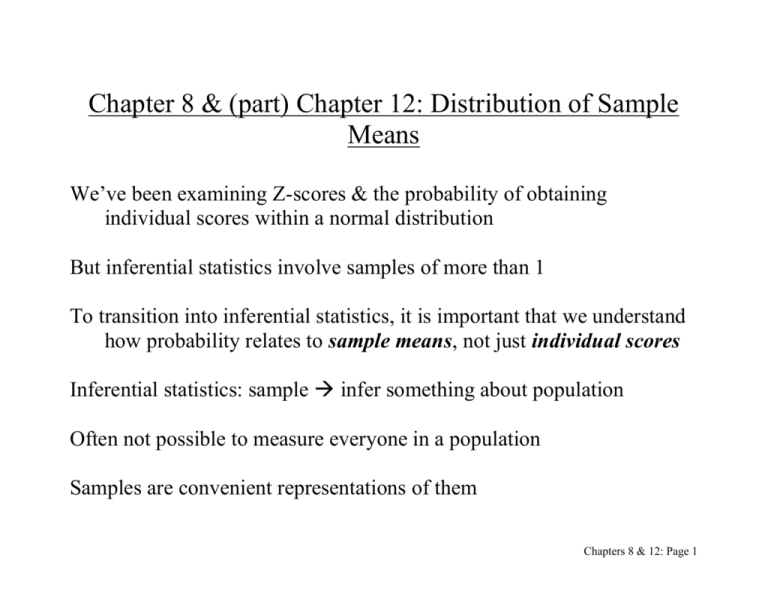DOC Chapter 7: Distribution of Sample Means
advertisement

Chapter 8 & (part) Chapter 12: Distribution of Sample Means We’ve been examining Z-scores & the probability of obtaining individual scores within a normal distribution But inferential statistics involve samples of more than 1 To transition into inferential statistics, it is important that we understand how probability relates to sample means, not just individual scores Inferential statistics: sample infer something about population Often not possible to measure everyone in a population Samples are convenient representations of them Chapters 8 & 12: Page 1 If you take multiple samples of the same size from a population, they are likely to give different results Samples vary! Quite likely that a particular sample won’t reflect the population exactly Discrepancy b/n sample & population = sampling error The term “sampling error” does not mean a sampling mistake – rather it indicates that means drawn from multiple samples taken from a population will vary from each other due to random chance and therefore may deviate from the population mean Chapters 8 & 12: Page 2 What is a distribution of Sample Means (Sampling Distribution of the Mean)? A distribution of sample means ( X ); a “distribution of a statistic [in this case a sample mean] over repeated sampling from a specified population” Based on all possible random samples of size n, from a population Can inform us of the degree of sample-to-sample variability we should expect due to chance Chapters 8 & 12: Page 3 Suppose we have a population: 6 7 8 9 = 7.5 Let’s take all possible samples of size n = 2 from this population: 1. 2. 3. 4. 5. 6. 6 6 6 6 7 7 6 7 8 9 6 7 X= X= X= X= X= X= 6.0 6.5 7.0 7.5 6.5 7.0 7. 8. 9. 10. 11. 12. 7 7 8 8 8 8 8 9 6 7 8 9 X= X= X= X= X= X= 7.5 8.0 7.0 7.5 8.0 8.5 13. 9 14. 9 6 7 15. 9 8 16. 9 9 X= X= X= X= 7.5 8.0 8.5 9.0 What do you notice? X is rarely exactly But, most X are close to (or cluster around) Extreme values of X are rare You can determine the exact probability of obtaining a particular X p( X < 7)? = 3 / 16 Chapters 8 & 12: Page 4 Important properties of the sampling distribution of means: 1. Mean 2. Standard Deviation 3. Shape 1. The Mean The mean of the distribution of sample means is the mean of the population The mean of the distribution of sample means is called expected value of X X is an unbiased estimate of : on average, the sample mean produces a value that exactly matches the population mean Chapters 8 & 12: Page 5 2. The Standard Deviation of the Distribution of Sample Means X = Standard Error of the Mean X = n Variability of X around Special type of standard deviation, type of “error” Average amount by which X deviates from Less error = better, more reliable estimate of population parameter Chapters 8 & 12: Page 6 X influenced by two things: (1) Sample size (n) Larger n = smaller standard errors Note: when n = 1 X = as “starting point” for X , X gets smaller as n increases (2) Variability in population () Larger = larger standard errors Chapters 8 & 12: Page 7 3. The Shape Central Limit Theorem = Distribution of sample means will approach a normal distribution as n approaches infinity Very important! True even when raw scores NOT normal! What about sample size? (1) If raw scores ARE normal, any n will do (2) If raw scores are not normal but are symmetrically distributed, a small n will usually suffice (3) If the raw scores are severely skewed, n must be “sufficiently large” For most distributions n 30 Chapters 8 & 12: Page 8 Why are Sampling Distributions Important? Tell us the probability of getting a particular X , given & Critical for inferential statistics! Allow us to estimate population parameters Allow us to determine if a sample mean differs from a known population mean just because of chance Allow us to compare differences between sample means – due to chance or to experimental treatment? Sampling distribution is the most fundamental concept underlying all statistical tests Chapters 8 & 12: Page 9 Working with the Distribution of Sample Means If we assume DSM is normal (again, we can do this if raw scores are normally distributed or n is at least 30) AND If we know & We can use the Normal Curve & Table E.10! z x x where: X = n Chapters 8 & 12: Page 10 Example: Suppose you take a sample of 25 high-school students, and measure their IQ. Assuming that IQ is normally distributed with = 100 and = 15, what is the probability that your sample’s IQ will be 105 or greater? Step 1: Convert to Z-score: z x x X = 15 15 3 25 5 105 100 z 1.67 3 Step 2: See Table E. 10 The probability of the sample having a mean of 105 or greater is: 0.0475 Chapters 8 & 12: Page 11 Example: Repeat the same problem in the previous example, but assume your sample size is 64 Step 1: Convert to Z-score: z x x X = 15 15 1.875 64 8 105 100 z 2.67 1.875 Step 2: See Table E. 10 The probability of the sample having a mean of 105 or greater is: 0.0038 Chapters 8 & 12: Page 12 Example: What X marks the point above which sample means are likely to occur only 15% of the time, if n = 36? Step 1: Find X = n X = 15 15 2.5 36 6 Step 2: See Table E. 10 : Z = ? Step 3: Solve for X : X = + Z X X = 100 + (?)(2.5) = 102.6 Chapters 8 & 12: Page 13







